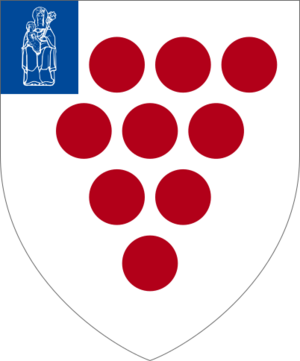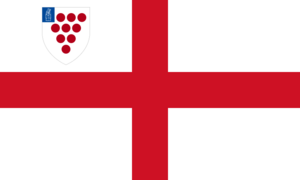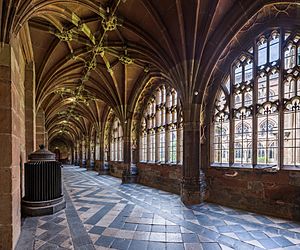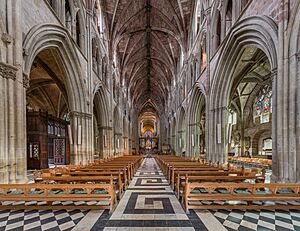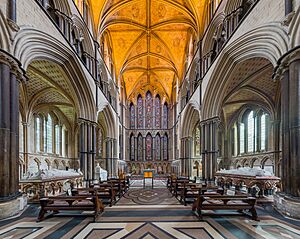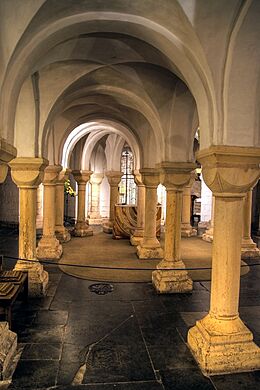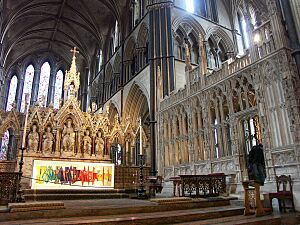Worcester Cathedral facts for kids
Quick facts for kids Worcester Cathedral |
|
|---|---|
| Cathedral Church of Christ and Blessed Mary the Virgin | |
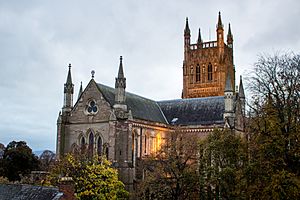
Worcester Cathedral
|
|
| Lua error in Module:Location_map at line 420: attempt to index field 'wikibase' (a nil value). | |
| Location | Worcester (Worcestershire) |
| Country | England |
| Denomination | Church of England |
| Previous denomination | Roman Catholic |
| Website | worcestercathedral.co.uk |
| History | |
| Former name(s) | Worcester Priory |
| Architecture | |
| Functional status | Active |
| Style | Norman, Gothic |
| Years built | 1084–1504 |
| Specifications | |
| Length | 130 m (426.51 ft) |
| Nave length | 53 m (173.88 ft) |
| Width | 44 m (144.36 ft) |
| Nave width | 9 m (29.53 ft) |
| Nave height | 20 m (65.62 ft) |
| Number of towers | 1 |
| Tower height | 62 m (203.41 ft) |
| Bells | 16 hung for change ringing |
| Tenor bell weight | 48cwt - 0qr - 2lb in B |
| Administration | |
| Diocese | Worcester (since 670) |
| Province | Canterbury |
Worcester Cathedral is a big church in Worcester, England. Its full name is the Cathedral Church of Christ and Blessed Mary the Virgin. It belongs to the Church of England. It's the main church for the Bishop of Worcester and the whole Worcester area. A dean and a group of leaders manage it. This amazing building is protected as a Grade I listed building and a scheduled monument, meaning it's super important!
The cathedral started way back in 680. The oldest parts you can still see today were built in 1084. Bishop Wulfstan rebuilt the cathedral in the Romanesque style. The chapter house was built in 1120. The main part of the church, called the nave, was made longer in the 1170s. Between 1224 and 1269, the east end was rebuilt in the Early English Gothic style. The rest of the nave was rebuilt in the 1360s. The beautiful central tower was finished in 1374. The cathedral still has medieval wooden seats called misericords. These are now part of the Victorian choir stalls. The cathedral was greatly repaired in the 1800s. It has many furnishings designed by George Gilbert Scott. You can also find tombs of important people here. These include King John, Arthur, Prince of Wales, and former prime minister Stanley Baldwin.
Contents
History of Worcester Cathedral
How the Cathedral Began
The cathedral was founded in 680. A priest named Tatwine was chosen to be its first bishop. But he passed away before he could officially start. So, Bishop Bosel became Worcester's first serving bishop. The first church was dedicated to Saints Peter and Paul. Sadly, no parts of that first church remain today. The underground part of the current cathedral, called the crypt, is from the 11th century. It was built during the time of Bishop Wulfstan.
In the early 700s, different groups of church workers were part of the cathedral community. Later, in the late 900s, the community became a formal monastery. This happened because of changes called the Benedictine reforms. Oswald, who was bishop from 961 to 992, had a strong connection with Fleury Abbey in France. He brought their monastic rules to Worcester. He set up a monastery around 966, which was dedicated to St. Mary, just like the current cathedral.
Medieval Times
Wulfstan, the bishop of Worcester, was the last Anglo-Saxon bishop. He lived until 1095 and was later made a saint. The cathedral is where King John was buried. He passed away in 1216.
The cathedral priory was a big religious group in the city. It owned a lot of land and was very powerful. It was a center for learning and provided schooling. It also helped with hospitals. The church received money from local taxes. It also enforced church laws about Christian behavior. This could lead to punishments for people. The priory had strong ties with important local families. So, it played a huge role in the daily life of the city and county during medieval times.
Worcester's Jewish Community
The church leaders in Worcester were not very friendly towards the small Jewish community. Around 1190, a bishop asked Peter of Blois to write a book against Jewish people. In 1219, William de Blois, as Bishop of Worcester, made very strict rules for Jews. Like in other parts of England, Jews had to wear special white badges. Bishop Blois also tried to stop them from lending money with interest. He even wrote to Pope Gregory IX in 1229 asking for harsher rules. The Pope then said Christians should not work in Jewish homes. He also insisted that Jews must wear their badges.
Changes During the Reformation
The priory ended when King Henry VIII closed down monasteries. This was called the Dissolution of the Monasteries. Just before this, in 1535, the leader of the priory, William More, stepped down. Henry Holbeach took his place. William More was known for living well, but his lifestyle was common for church leaders then. However, there were problems with how the priory was run. There were disagreements among the monks.
The Protestant Hugh Latimer became bishop in 1535. He preached about making changes and removing religious images. He resigned in 1539 because King Henry VIII changed his religious views. John Bell, who was a moderate reformer, was bishop from 1539 to 1543. This was when the priory was dissolved.
In the early 1500s, Worcester had about 40 monks. This number went down a bit just before 1540. It seems they stopped taking in new monks. When the priory closed, probably on January 16, 1540, there were 35 Benedictine monks and their leader, Prior Holbeach. Eleven monks immediately received pensions. The rest became regular priests in the new Royal College. Holbeach became the first Dean. Five more former monks received pensions in July 1540.
The old monastery library had many old books. These are now spread out in different libraries. You can find them in Cambridge, London, Oxford, and the current Worcester Cathedral library. Parts of the priory from the 12th and 13th centuries can still be seen today.
Nicholas Heath, who became bishop after John Bell, was much more traditional and Catholic in his beliefs.
The Civil War Period
During the Civil War, the cathedral was used to store weapons. This might have started as early as September 1642. Worcester supported the King. Royalist soldiers quickly took over the city. They were using the cathedral to store supplies. Then, the Earl of Essex and his Parliament troops briefly took back the city. They then damaged the cathedral. Stained glass windows were broken. The organ was destroyed, along with library books and monuments.
The position of bishop was removed during the Commonwealth and Protectorate periods, from about 1646 to 1660. The bell tower was pulled down in 1647. The building was used as a prison after a battle in 1651.
From Victorian Times to Today
In the 1860s, the cathedral had a lot of major repair work. This was planned by Sir George Gilbert Scott and A. E. Perkins.
An image of the cathedral's front appeared on the back of the British £20 note. This note honored Sir Edward Elgar. It was printed between 1999 and 2007. It was legal money until June 30, 2010.
Cathedral Architecture
Worcester Cathedral has many features typical of an old English cathedral. Like Salisbury and Lincoln, it has two transepts. These are parts that cross the main nave, unlike the single transept often seen in Europe. This design helped many priests or monks say their prayers privately. Worcester also has a chapter house and a cloister, which are common in English cathedrals. On the north side, there is an entrance porch. This was built to stop drafts from blowing through the cathedral when the main doors were open.
Important parts of the building date from every century, from the 11th to the 16th. Its tower is in the Perpendicular style. It is described as "exquisite" and looks best from across the River Severn.
The oldest part of Worcester Cathedral is the crypt. This underground area has many columns in the Norman style. It has round tops on the columns, called cushion capitals. These are from the first monastery church started by Saint Wulfstan of Worcester in 1084. Also from the Norman period is the round chapter house, built in 1120. It was made octagonal on the outside when its walls were strengthened in the 14th century. The nave was built and rebuilt over 200 years, from 1170 to 1374. Different architects worked on it, using various styles. Some parts show a unique mix of Norman and Gothic styles. The oldest sections have alternating layers of green sandstone from Highley and yellow Cotswold limestone.
The east end was rebuilt over the Norman crypt by Alexander Mason. This happened between 1224 and 1269. It is in a very similar Early English style to Salisbury Cathedral. From 1360, John Clyve finished the nave. He built its arched ceiling, the west front, the north porch, and the eastern part of the cloister. He also made the Norman chapter house stronger, adding supports and changing its ceiling. His best work is the central tower from 1374. It used to have a wooden, lead-covered spire on top, but that is gone now. Between 1404 and 1432, an unknown architect added the north and south parts to the cloister. The western part was finished by John Chapman from 1435 to 1438. The last important addition is Prince Arthur’s Chantry Chapel. This is to the right of the south choir aisle and was built from 1502 to 1504.
Worcester Cathedral was greatly repaired from 1857 to 1874. This work was done by W. A. Perkins and Sir George Gilbert Scott. Most of the church furniture and stained glass windows are from this time. Some old screens and wood panels from the early 1600s were removed in 1864. They are now at Holy Trinity Church, Sutton Coldfield.
Cathedral Leaders
The cathedral is led by a Dean and a group of Canons.
- Dean – Stephen Edwards (started in September 2024)
- Residentiary Canon (Precentor) – vacant
- Residentiary Canon (Librarian & Chaplain to St Oswald's) – Kimberly Bohan (started in January 2023)
- Senior Non-executive Canon – Dr David Bryer
- Non-executive Canon – Anne Penn
- Non-executive Canon – Henry Briggs
- Non-executive Canon – Staffan Engström
Tombs and Memorials
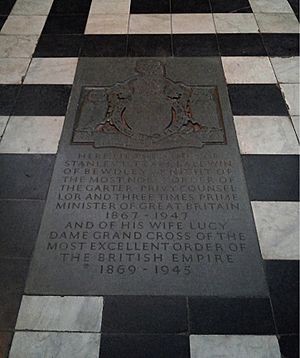
The cathedral holds the tomb of King John in its main worship area. Before he passed away in Newark in 1216, King John asked to be buried at Worcester. He is buried between the shrines of St Wulfstan and St Oswald. These shrines are now gone.
The cathedral also has a special memorial for Prince Arthur Tudor. This is called Prince Arthur's Chantry, and he is buried here. Arthur was the older brother of Henry VIII. Worcester Cathedral suffered a lot of damage during the English Reformation. But Henry VIII spared it from total destruction because of his brother's chapel inside.
A Latin message for Henry Bright is near the north porch. He was the headmaster of the King's School, Worcester. Other important people buried here include:
- Godfrey Giffard (c. 1235 – 1302), a powerful government official and Bishop of Worcester.
- Ivor Atkins (1869–1953), who was the choirmaster and organist at Worcester Cathedral for many years.
- Stanley Baldwin (1867-1947), who was the Prime Minister of the United Kingdom three times, and his wife Lucy (1869-1945).
- Alfred Barry (1826–1910), who was once the Bishop of Sydney in Australia.
- Richard Edes (d. 1604), a chaplain to Queen Elizabeth I and King James I.
- John Gauden (1605–1662), Bishop of Worcester.
- Philip Goodrich (1929–2001), Bishop of Worcester from 1982 to 1996.
- William Hamilton, 2nd Duke of Hamilton (1616–1651), a Scottish Royalist leader.
- Sir Thomas Lyttelton, 1st Baronet (1593–1650).
- William Henry Reed (1876–1942), a violinist and friend of the composer Edward Elgar.
- Robin Woods (1914–1997), Bishop of Worcester from 1971 to 1982.
- Francis Brett Young (1884–1954), an author from Worcestershire.
Cathedral Library
The Cathedral Library at Worcester is located in the loft above the South Nave. It holds 289 medieval manuscripts. These are old books written by hand. It also has 55 incunabula, which are books printed before 1501. Plus, there are 6600 printed books from after that time. The library and archives also have 19000 old documents. There is also a music collection with works from famous composers like Edward Elgar.
Some very special items include the Worcester Antiphoner. This is a unique type of prayer book that survived the Reformation. The will of King John is also here. And there is a copy of the Magna Carta from 1225. The large scriptorium at Worcester was a place where many manuscripts were made. Many famous scribes worked there. This includes the writer John of Worcester and a monk known as The Tremulous Hand of Worcester.
Misericords
Thirty-nine of the misericords are from 1379. These are special wooden seats in the choir. They include a full set showing the Labours of the Months. These carvings show daily life and work throughout the year. The carvings also show Bible stories, myths, and folk tales. For example, N-07, The Clever Daughter, shows a woman draped in a net, riding a goat. She also carries a rabbit. Three of the misericords were replaced in Victorian times. For example, N-02 shows Judas in the jaws of Satan.
Cathedral Bells
The tower has a ring of twelve bells. It also has four extra bells for semitones. There is also a very large, non-swinging bell called a bourdon. This bell weighs 4.1 tonnes. The current set of 15 ringing bells were made in 1928. They were cast by John Taylor & Co. in Loughborough. They used the metal from the original bells made in 1869. The bourdon bell was made in 1869 and retuned in 1928. It is only used by the clock to strike the hours. Sometimes it tolls for special events.
This set of bells is the sixth heaviest ring of twelve in the world. Only the bells in Liverpool, Exeter, York, St Paul's in London, and St Mary Redcliffe in Bristol are heavier. The bells are also thought to have one of the best tones ever. They are very close to the sound of the bells at York Minster. The bells hang in a wooden frame built in 1869 for the previous set. Worcester Cathedral is special because it has a teaching center. This center has eight training bells linked to computers. This helps people learn to ring bells. The Cathedral is also known for being the only church in the world with a ring of ten bells in a harmonic minor key.
Music at the Cathedral
Worcester Cathedral has three choirs. The main one is the Worcester Cathedral Choir. It has both boys' and girls' sections that usually sing separately. There is also the Worcester Cathedral Voluntary Choir and the Worcester Cathedral Chamber Choir. All three choirs took part in BBC broadcasts of Christmas services in 2007. The boys' choir led one service, and the girls' choir led the other. Since the 1700s, Worcester Cathedral Choir has been part of the Three Choirs Festival. This is the oldest music festival in the world.
The famous composer Edward Elgar lived most of his life in Worcestershire. The first performance of the updated version of his Enigma Variations happened at the cathedral. This was during the 1899 Three Choirs Festival. He is remembered in a stained glass window that shows his picture.
Worcester Cathedral has a long history of organs, going back to at least 1417. Many organs have been rebuilt or replaced over time. Famous organ builders like Thomas Dallam, William Hill, and Robert Hope-Jones worked on them. The Hope-Jones organ from 1896 was greatly rebuilt in 1925 by Harrison & Harrison. Smaller repairs kept it working until 1978. It was a large organ with four keyboards and 61 stops. It had a big Gothic Revival case with decorated pipes. There were also two smaller cases on either side of the choir.
This organ (except for the large transept case and some pedal pipes) was removed in 2006. A new organ by Kenneth Tickell was finished in the summer of 2008. The nave has a separate Rodgers organ with three keyboards.
Many famous organists have worked at Worcester. These include Thomas Tomkins (from 1596), Hugh Blair (from 1895), Ivor Atkins (from 1897), and David Willcocks (from 1950). From 2012 to 2018, the Director of Music and Organist was Peter Nardone.
Events at the Cathedral
Worcester Cathedral hosts the yearly graduation ceremonies for the University of Worcester. These events are led by the university's vice-chancellor. They happen over four days in November.
Since 2018, Worcester Cathedral has also hosted the yearly honors celebration for the Royal Life Saving Society UK. This event celebrates the long service and great achievements of their members who save lives.
Images for kids
See also
 In Spanish: Catedral de Worcester para niños
In Spanish: Catedral de Worcester para niños
- Ealdred (archbishop of York)
- Bishop of Worcester
- Worcester Cathedral Voluntary Choir
- Architecture of the medieval cathedrals of England
- List of Gothic Cathedrals in Europe
- English Gothic architecture
- Romanesque architecture
- Church of England


